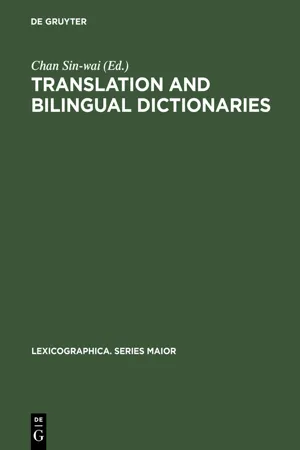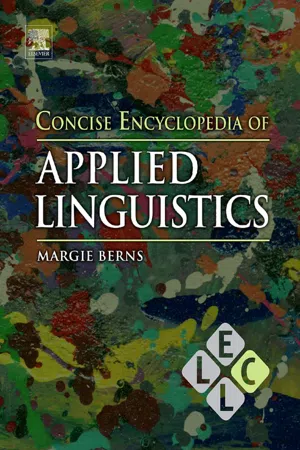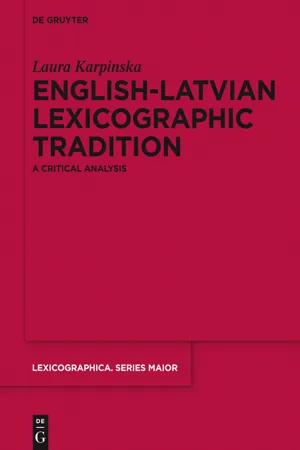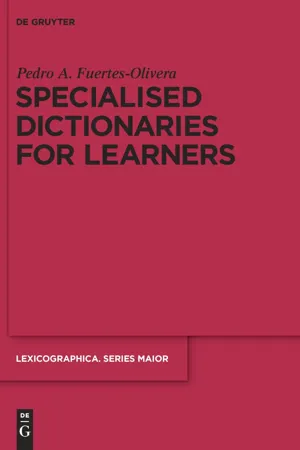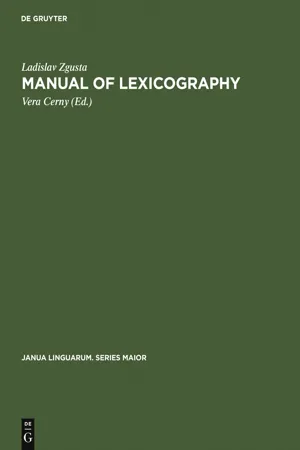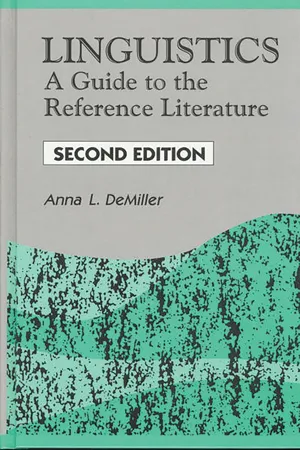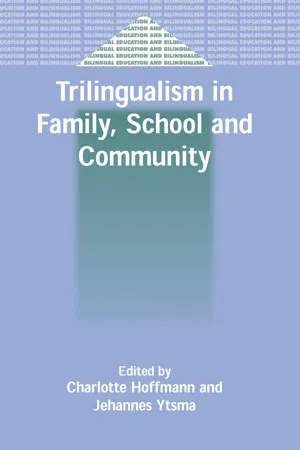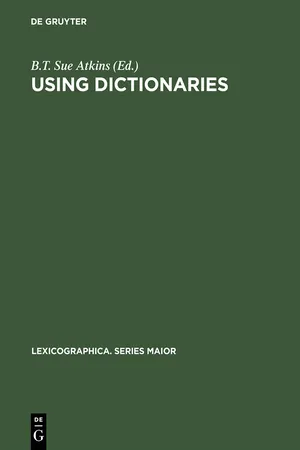Languages & Linguistics
Bilingual Dictionaries
Bilingual dictionaries are reference tools that provide translations and definitions for words and phrases in two languages. They are designed to help speakers of one language understand and communicate in another language. Bilingual dictionaries are commonly used by language learners, translators, and individuals who need to navigate between two languages in their daily lives.
Written by Perlego with AI-assistance
Related key terms
1 of 5
10 Key excerpts on "Bilingual Dictionaries"
- eBook - PDF
- Chan Sin-wai(Author)
- 2013(Publication Date)
- De Gruyter(Publisher)
In this paper, at least, I will argue that monolingual dictionaries, together with Bilingual Dictionaries the other way around, e.g. Language 2 to Language 1 (L2-L1) dictionaries when translating from LI into L2 and vice versa - are far the best ones to provide solutions to a number of problems frequently popping up during the translation process. 2. The Concept of the Bilingual Dictionary As the problem of the usefulness of Bilingual Dictionaries for translation purposes has already been raised, this and the following section will deal with the concepts of Bilingual Dictionaries and translation dictionaries in order to clarify up to what point a bilingual dictionary is a translation dictionary and whether a translation dictionary is always a bilingual dictionary. In order to discuss these questions, four dictionaries of lexicography published during the last seven years have been consulted. The dictionaries are: • Diccionario de lexicografia práctica (de Sousa 1995) • Nordisk leksikografisk ordbok (Bergenholtz et al. 1997) • Dictionary of Lexicography (Hartmann and James 1998) • Lexicography. A Dictionary of Basic Terminology (Burkhanov 1998) 24 Sven Tarp The first of these dictionaries is Spanish; the second is Norwegian and the result of a joint Nordic project, while the two remaining are English. I have translated the quotations from the two former dictionaries. Under the lemma bilingual dictionary de Sousa (1995: 129) provides the following short definition: Plurilingual dictionary that registers the equivalencies of the meanings in two languages. Such a short definition of a complex reality is always a problem, as it tends to exclude a number of important characteristics. Especially the expression equivalencies of the meanings in two languages could lead to the conclusion that we are dealing with a two-way dictionary. - eBook - PDF
- Margie Berns(Author)
- 2010(Publication Date)
- Elsevier(Publisher)
Why? Because a bilingual dictionary is the description of a source language (language A) using only some of the resources of the target language (language B). A compilation of those resources used for the target language does not itself constitute a framework for language B as a source language. There is no reason to believe that all the expressions of language B that need translation will be present in the terms used to translate language A. Another temptation is to use two dictionaries with the same source language A > B and A > C to create a B > C or C > B diction-aries. Again, this tends to result in an inadequate (and distorted) word list. The Limitations of Bilingual Lexicography The limitations of Bilingual Dictionaries are quickly reached for such items as jokes, puns, and palindromes. Tran-slators working within the context of a novel or a story will work hard to find solutions, but a general bilingual dictionary cannot begin to deal with these things. Another area where Bilingual Dictionaries cannot provide all the help that is necessary or desirable for translators or foreign readers lies in cultural dif-ferences and connotations. A translation may be completely correct at the word level, but the back-ground will remain unexplained. Worse still, there will be no usable equivalent terms, because of cultural differences. In order to compensate for these gaps, some bilingual dictionary publishers now add little cultural notes to supply extra-linguistic information. This stilll leaves translators to their own devices to find a suitable solution. Bilingual Dictionaries Today and Tomorrow The world of dictionaries is evolving at great speed with free online dictionaries, scientific project dic-tionaries, and all sorts of other independent enter-prises, as well as commercial projects. Commercial 120 Bilingual Lexicography - eBook - ePub
English-Latvian Lexicographic Tradition
A Critical Analysis
- Laura Karpinska(Author)
- 2015(Publication Date)
- De Gruyter(Publisher)
Who are the users of Bilingual Dictionaries, and what are their needs? For what purposes do they use Bilingual Dictionaries? It is important to find answers to these questions before a further investigation into dictionary functions. It has to be noted that the discussion will focus on the users of general Bilingual Dictionaries.Kromann et al. (1991: 2712) point out that Bilingual Dictionaries are used in various spheres of life and for various purposes that accordingly determine the scope of the user groups:Bilingual Dictionaries are important tools in language-learning all the way from primaryschool to university level. They are useful aids to travel abroad and communication in foreign languages, necessary tools in the commercial world and public administration, and indispensable for secretaries dealing with foreign-language correspondence, translators and interpreters.This description of the purposes the Bilingual Dictionaries are used for also reveals the range of their potential users: students at different levels of foreign language proficiency, people who travel abroad (for recreation or business purposes), secretaries, translators and interpreters – probably more potential users could be added to the list, however, it is more important to clarify what common needs are shared by these various groups of users. The metalexicographic literature reveals that the users of Bilingual Dictionaries:–can be involved in the following types of linguistic activities: reading, writing, listening and speaking (Svensén 2009 : 12);–they need to perform translation form L2 to L1 or produce texts in L2 (Zgusta 1971 : 216; Kromann et al. 1991 : 2712).It can be inferred that the potential users of Bilingual Dictionaries need them when involved in the four basic linguistic activities which are combined with the translation from L1 into L2 and vice versa from L2 into L1.Svensén (ibid.) suggests that the four basic types of linguistic activities should:be grouped in pairs, differentiating between more ‘passive’ RECEPTION (reading and listening) and more ‘active’ PRODUCTION (writing and speaking). In broad terms, reception (or DECODING) is finding a certain content on the basis of a given form, whereas production (or ENCODING - eBook - PDF
- Pedro A. Fuertes-Olivera(Author)
- 2010(Publication Date)
- De Gruyter(Publisher)
C HAPTER 5. The Bilingual Specialised Translation Dictionary for Learners Ildikó Fata Abstract As transpires from the title, this chapter is primarily concerned with (bilingual) specialised dictionaries for a special group of learners, i.e. translators, devised to comply with their wishes and expectations regarding specialised dictionaries, whether existing or assumed, before, during and after the translation process. Undoubtedly, a (bilingual) dictionary for translation purposes is by no means an exclusive aid for the translator, but with their optimum and user oriented design the number of auxiliary materials consulted during the translation process may be considerably reduced from the current eight or ten. The main objective of this chapter is to present both the “translation dictionary for LSP” and the “specialised dictionary for translation purposes” as an interesting, if highly complex, dictionary type which can ideally have many more functions and hence cover many more user situations than demonstrated and realised by research literature. In placing the above dictionary type in a metalexicographic framework, as well as in defining its concept and genuine purpose, all further theoretical and practical considerations will be based on the latest functional studies (Bergenholtz / Tarp, 2002; Tarp, 2002, 2004, 2005b), arising from practical lexicographic needs. The high number of user situations that a translation oriented specialised dictionary may ideally cover, whether cognitive or communicative, presents current modern lexicographic theory with new challenges, while present-day problems point to the limitations of traditional dictionary definitions as to what should be the subject of further research. - eBook - PDF
- Ladislav Zgusta, Vera Cerny(Authors)
- 2010(Publication Date)
- De Gruyter Mouton(Publisher)
As already stated the coinage of innovations is not a purely lexicographic activity in the proper sense of the word (cf. § 4.4), though lexicography usually is vastly useful in filling these semantic gaps. It should be mentioned that dictionaries of this type for many different target languages were compiled in the U.S.S.R. in 45 Cf. Nida UAL 24, 1958, 280. — As example of a dictionary of this type can be quoted the forthcoming Papago dictionary by M. Mathiot, or, as Petraoek reports, Ch. Le Coeur's ethnographic dictionary of Teda (Central Sahara). THE BILINGUAL DICTIONARY 307 the late twenties and in the thirties, the source language being, obviously, Russian. 46 In different other parts of the world, various institutions cope with similar tasks, as examples, Zima reports the Hausa Language Board, the Bureau of Ghana Languages, the Sierra Leone Language Bureau, the Translation Bureau in Gambia, etc. COLLECTION OP MATERIAL 7.4 In the following sections, we shall discuss some points relevant to the lexicographer's work on a bilingual dictionary. These sections should in no case be read or understood in isolation, but only as complementing or modifying what has been stated in the respective discussions of the monolingual dic-tionary. As far as the collection of material goes, the bilingual lexicographer is in an enviable situation if there is already a good, comprehensive, descriptive monolingual dictionary, 47 preferably of the standard-descriptive type or an overall-descriptive one with a standard-descriptive nucleus at least of the non-native language of his pair of languages, but even more if there are such dic-tionaries of both of them. The absense of such a dictionary is always a serious handicap, because the lexicographer himself must then do much descriptive and other work which should in fact be done by the monolingual dictionary. - eBook - ePub
Introducing Second Language Acquisition
Perspectives and Practices
- Kirsten M. Hummel(Author)
- 2013(Publication Date)
- Wiley-Blackwell(Publisher)
www.the-fools-journey.blogspot.com .There have been a number of perspectives on bilingualism over the years, and, as a consequence, differences in how to define “a bilingual.” Leonard Bloomfield, a renowned American structuralist linguist working in the early part of the last century, considered a bilingual to be someone with “native-like control of two languages” (1933, p. 56). In a similar vein, the Swedish linguist, Bertil Malmberg (1977, pp. 134–135), described a bilingual in the following way:A bilingual is an individual who, in addition to his mother tongue, has acquired from childhood onwards or from an early age a second language by natural means (in principle not by formal instruction), so that he has become a fully competent member of the other linguistic community within the sphere, the occupational or social group, to which he naturally belongs.According to the definitions offered by Bloomfield and Malmberg, both Alberto and Walid are indeed bilinguals. On the other hand, other specialists are not quite so categorical in requiring full and “native-like control” in order for one to qualify as “bilingual.” For instance, for the sociolinguist Einar Haugen (1953, p. 7) bilingualism is: “the point where a speaker can first produce complete meaningful utterances in the other language.” For the Canadian sociolinguist William Mackey (1962, p. 52), bilingualism is: “the alternate use of two or more languages by the same individual.” He specified (1956, p. 8): “Bilingualism is entirely relative, the point at which a speaker of a second language becomes bilingual is either arbitrary or impossible to determine.” Uriel Weinreich (1953) defined bilingualism as “the practice of alternately using two languages.” In more recent times, the sociolinguist Li Wei (2007, p. 7) described a bilingual as: “someone with the possession of two languages.” According to the definitions proposed by Haugan, Mackey, Weinreich, and Wei, in addition to Alberto and Walid, we can consider Mila, as well as the other L2 learners who have guided our discussions throughout this book, Steve, Linda, and Xia Mei, as bilinguals. We see then that the person who is considered to be bilingual varies considerably according to the way in which this term is defined. - Colin Baker, Wayne E. Wright, Prof. Wayne E. Wright(Authors)
- 2021(Publication Date)
- Multilingual Matters(Publisher)
CHAPTER 1 Bilingualism and Multilingualism: Definitions and Distinctions Introduction Terminology Some Dimensions of Bilingualism and Multilingualism An Individual's Use of Two or More Languages Language Choice Bilingual and Multilingual Ability The Four Language Skills Degrees of Bilingualism The Monolingual View of Bilingualism The Holistic View of Bilingualism Language Proficiency Communicative Competence ConclusionCHAPTER 1 Bilingualism and Multilingualism: Definitions and Distinctions IntroductionSince a bicycle has two wheels and binoculars are for two eyes, it would seem that bilingualism is simply about two languages. Likewise, multilingualism seems simply to be about two or more languages. While bilingualism and multilingualism are different, for the sake of brevity multilingualism will be combined under bilingualism where there is similarity, and distinctions will be made only as necessary.The aim of this chapter is to show that the ownership of two or more languages is not so simple as having two wheels on a bicycle. Is someone bilingual if they are fluent in one language but less than fluent in their other language? Is someone bilingual if they rarely or never use one of their languages? Is someone multilingual if they have memorized a handful of words and phrases in other languages? Such questions need addressing before other topics in this book can be discussed.To understand the answers to these questions, it is valuable to make an initial distinction between bilingualism and multilingualism as an individual characteristic, and bilingualism and multilingualism in a social group, community, region or country. Bilingualism and multilingualism can be examined as the possession of the individual. Various themes in this book start with bilingualism as experienced by individual people. For example, a discussion of whether or not bilingualism affects thinking requires research on monolingual- eBook - PDF
Linguistics
A Guide to the Reference Literature
- Anna L. DeMiller(Author)
- 2000(Publication Date)
- Libraries Unlimited(Publisher)
Parti GENERAL LINGUISTICS This page intentionally left blank 1 Dictionaries, Encyclopedias, Guides, and Surveys The terms "dictionary" and "encyclopedia" have been broadly interpreted in this chapter to survey a range of reference sources variously calling themselves dictionaries, lexicons, indexes of terms, glossaries, encyclopedias, surveys, guides, and handbooks. The use of one of these words in a title, however, can be deceptive as, for example, some of the entries below call themselves dictionaries, but in reality provide no definitions, just indexes of terms. Some are hybrids, such as the encyclopedic dictionaries or the dictionaries that provide definitions, but also have indexes of terms for other languages. Works listed here range from comprehensive to narrow in scope and from highly technical to very basic. Dictionaries of just traditional grammatical terms are excluded. Monolingual reference sources may be included if in English, German, or French. Bilingual and multilingual dictionaries may be included if in one or more of the above three languages. To point the user to the best of a wide choice of dictionaries, coverage is selective and annotations point out differences among similar works. 1. Abraham, Werner. Terminologie zur neueren Linguistik. 2. vollig neu bearb. u. erw. Aufl. Tubingen: Max Niemeyer, 1988. 2v. 1059p. index, illus. bibliog. (Germanistische Arbeitshefte: Erganzungsreihe, 1; ISSN 0344-6700). ISBN 3-484-10605-0. The second edition of this already excellent dictionary for contemporary linguistics has now been considerably enlarged and brought up to date. Volume 1 is A-L; volume 2 is M-Z. Entries vary in length from a few lines to a few pages though some are as long as six pages. Head terms are alphabetically arranged with English translations of the terms often given. Many definitions are drawn from original sources, most in German, but a considerable number in English as well. - Charlotte Hoffmann, Jehannes Ytsma(Authors)
- 2003(Publication Date)
- Multilingual Matters(Publisher)
Also, (bi)lingualism is premised on the existence of two or more linguistic codes, i.e. languages distinguished according to their linguistic form or substance, while (di)glossia is premised on the existence of two or more linguistic varieties, i.e. languages distinguished according to their (socio)linguistic function. In other words, the emphasis of this notion is on diversity, while the emphasis of ‘multilinguality’ is on the impenetra-bility, complexity and unity of the phenomena. Each individual possesses his/her own multilinguality, which depends on a set or sets of languages (or constellations, as Hoffmann (2001a: 20) puts 1111 2 3 4 5 6 7 8 9 1011 1 2 3111 4 5 6 7 8 9 20111 1 2 3 4 5 6 7 8 9 30111 1 2 3 4 5 6 7 8 9 40 41111 18 Contexts of Trilingualism 18 it), levels of mastery of each language etc. Multilinguality, therefore, con-stitutes an individual subset of the universality of multilingualism, while still reflecting the essential characteristics of multilingualism. Multilin-guality also includes cognitive and linguistic abilities, potential to gain knowledge, self-image as a language-learner, preferences and the tangible impact of the cultural context. Every multilingual individual possesses a real concrete multilinguality of his or her own. At the same time, groups of people and populations who live in the same environment, e.g. groups of immigrants, may have typical sets of languages in use that are common for (the majority of) this population. For example, for Russian immigrants to Israel the most essen-tial languages for their survival in the host society would be Russian (L1), Hebrew – the official language of the country they have come to live in, and English – the language of academic studies, promotion and prestige in Israel, and also the language that may substitute for the yet imperfect command of Hebrew. We call such constellations Dominant Language Constellations (DLCs).- eBook - PDF
Using Dictionaries
Studies of Dictionary Use by Language Learners and Translators
- B.T. Sue Atkins, B. T. Sue Atkins(Authors)
- 2015(Publication Date)
- De Gruyter(Publisher)
This study takes a step in that direction. 2. Objectives The purpose of this study was to gather information on how student translators use diction-aries when translating from a foreign language into a native one (L2-L1 translation), and to see what effects certain aspects of dictionaries have on them. One aspect to which we paid par- 124 Kristen Mackintosh ticular attention was definitional metalanguage (i.e., the language used in dictionary defini-tions). Our study was limited to translation between English and French, and it concentrated primarily on the translation of specialized texts (i.e., texts that fall on the dine between general-language texts and highly technical ones). It is our hope that the findings of this study will provide insight into how dictionaries could be designed specifically for use by students doing L2-L1 translation, and how student translators could be better trained to use their dictionaries in this task. 1 3. Focus of the study Research is needed for many different user groups in various contexts of dictionary use, yet for several reasons, we chose to concentrate on students doing L2-L1 translation. The focus on translation was an obvious choice, as the study was conducted as part of an MA thesis on translation. Furthermore, research tapping the potential of electronic dictionaries seems especially urgent for translation, for, as Starren & Thelen (1990:447) have explained, transla-tion requires a dictionary which is organized in such a way that the information contained in it is easily accessible on the one hand, and as exhaustive as possible on the other. This need makes paper-based dictionaries particularly unsatisfactory for translation purposes. They are probably most unsatisfactory for L1-L2 translation, but we chose to focus on L2-L1 transla-tion (both English-French and French-English) because it is the type of translation that is most commonly taught and practised in Canada, where we work.
Index pages curate the most relevant extracts from our library of academic textbooks. They’ve been created using an in-house natural language model (NLM), each adding context and meaning to key research topics.
